第 10 章 树结构基础部分
1 树结构基础部分
1.1 为什么需要树这种数据结构
1)数组存储方式的分析
优点:
- 通过下标方式访问元素,速度快。对于有序数组,还可使用二分查找提高检索速度。
缺点:
- 如果要检索具体某个值,或者插入值(按一定顺序)会整体移动,效率较低
2)链式存储方式的分析
优点:
- 在一定程度上对数组存储方式有优化(比如:插入一个数值节点,只需要将插入节点,链接到链表中即可, 删除效率也很好)。
缺点:
- 在进行检索时,效率仍然较低,比如(检索某个值,需要从头节点开始遍历) 【示意图】
3) 树存储方式的分析
能提高数据存储,读取的效率, 比如利用 二叉排序树(Binary Sort Tree),既可以保证数据的检索速度,同时也可以保证数据的插入,删除,修改的速度。
1.2 树示意图
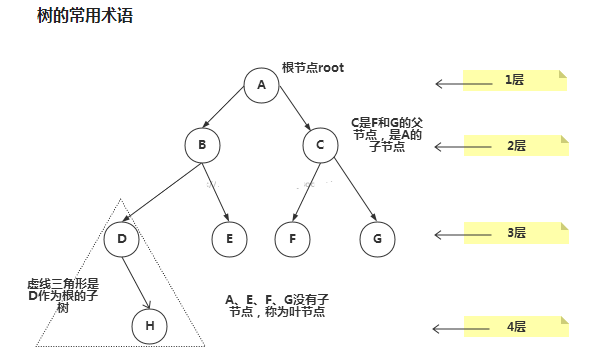
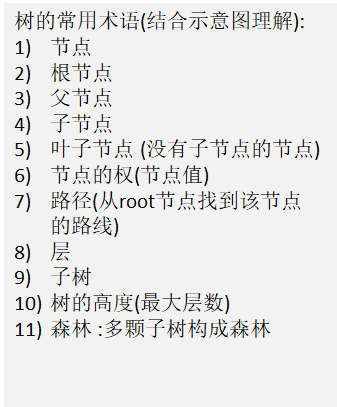
1.3 二叉树-的概念
- 树有很多种,每个节点最多只能有两个子节点的一种形式称为二叉树。
- 二叉树的子节点分为左节点和右节点。

- 如果该二叉树的所有叶子节点都在最后一层,并且结点总数=
2^n -1,n为层数,则我们称为满二叉树。 - 如果该二叉树的所有叶子节点都在最后一层或者倒数第二层,而且最后一层的叶子节点在左边连续,倒数第二层的叶子节点在右边连续,我们称为完全二叉树。

我们重点讲解一下二叉树的前序遍历,中序遍历和后序遍历。
1.4 二叉树-遍历的说明
使用前序,中序和后序对下面的二叉树进行遍历。
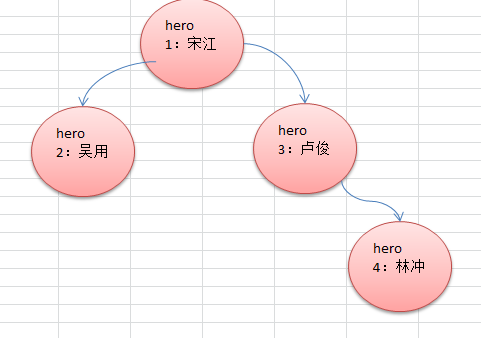
前序遍历: 先输出父节点,再遍历左子树和右子树
中序遍历: 先遍历左子树,再输出父节点,再遍历右子树
后序遍历: 先遍历左子树,再遍历右子树,最后输出父节点
小结: 看输出父节点的顺序,就确定是前序,中序还是后序
1.5 二叉树-遍历应用实例(前序,中序,后序)
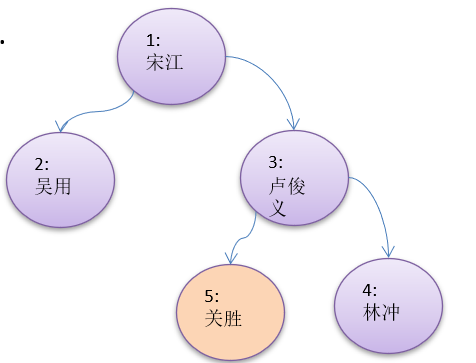

1.6 二叉树-查找指定节点
要求:
- 请编写前序查找,中序查找和后序查找的方法。
- 并分别使用三种查找方式,查找 heroNO = 5 的节点
- 并分析各种查找方式,分别比较了多少次
1.7 二叉树-删除节点
要求
- 如果删除的节点是叶子节点,则删除该节点
- 如果删除的节点是非叶子节点,则删除该子树.
- 测试,删除掉 5号叶子节点 和 3号子树.
代码实现:
package itcast01;
// 二叉树
/*
基本操作:
1. 遍历查找
2. 排序
3. 删除
*/
public class BinaryTreeDemo {
public static void main(String[] args) {
// 测试:
// 1. 先创建一个二叉树
BinaryTree binaryTree = new BinaryTree();
// 2. 创建节点
HeroNode root = new HeroNode(1, "宋江");
HeroNode node2 = new HeroNode(2, "吴用");
HeroNode node3 = new HeroNode(3, "卢俊义");
HeroNode node4 = new HeroNode(4, "林冲");
HeroNode node5 = new HeroNode(5, "关胜");
// 3. 加节点。说明: 我们先手动创建二叉树, 后面我们将学习递归的方式创建二叉树、
root.setLeft(node2);
root.setRight(node3);
node3.setRight(node4);
node3.setLeft(node5);
binaryTree.setRoot(root);
// 4. 测试:
// 4-1 前序排序
// System.out.println("前序遍历:");// 1, 2, 3, 5, 4
// binaryTree.preOrder();
// 4-2 中序排序
// System.out.println("中序遍历:");// 2, 1, 5, 3, 4
// binaryTree.infixOrder();
// 4-3 后序排序
// System.out.println("后序遍历:");// 2, 5, 4, 3, 1
// binaryTree.postOrder();
// 5-1 前序遍历
// 前序遍历 4次
// System.out.println("前序遍历方式:");
// HeroNode resNode = binaryTree.preOrderSearch(5);
// if (resNode != null) {
// System.out.printf("找到了, 信息为 no = %d name = %s\n", resNode.getNo(), resNode.getName());
// } else {
// System.out.printf("没有找打 no = %d 的英雄\n", 5);
// }
// 5-2 中序遍历
// 中序遍历 4次
// System.out.println("中序遍历方式:");
// HeroNode resNode2 = binaryTree.infixOrderSearch(5);
// if (resNode2 != null) {
// System.out.printf("找到了, 信息为 no = %d name = %s\n", resNode2.getNo(), resNode2.getName());
// } else {
// System.out.printf("没有找打 no = %d 的英雄\n", 5);
// }
// 5-3 后序遍历
// 中序遍历 4次
// System.out.println("后序遍历方式:");
// HeroNode resNode3 = binaryTree.postOrderSearch(5);
// if (resNode3 != null) {
// System.out.printf("找到了, 信息为 no = %d name = %s\n", resNode3.getNo(), resNode3.getName());
// } else {
// System.out.printf("没有找打 no = %d 的英雄\n", 5);
// }
// 测试一把删除结点的代码
System.out.println("删除前, 前序遍历");
binaryTree.preOrder();// 1, 2, 3, 5, 4
binaryTree.delNode(5);
System.out.println("删除后,前序遍历");
binaryTree.preOrder();// 1, 2, 3, 4
}
}
//定义一个BinaryTree 二叉树
class BinaryTree {
private HeroNode root;
public void setRoot(HeroNode root) {
this.root = root;
}
// 删除结点
public void delNode(int no) {
if(root != null) {
// 如果这个地方只有一个root节点, 这里立即判断root是不是就是要删除的节点
if (root.getNo() == no) {
root = null;
} else {
// 递归删除即可
root.delNode(no);
}
}else {
System.out.println("空树, 不能删除~");
}
}
//前序遍历
public void preOrder() {
if (this.root != null) {
this.root.preOrder();
} else {
System.out.println("二叉树为空, 不可遍历。");
}
}
//中序遍历
public void infixOrder() {
if (this.root != null) {
this.root.infixOrder();
} else {
System.out.println("二叉树为空, 不可遍历。");
}
}
//后序遍历
public void postOrder() {
if (this.root != null) {
this.root.postOrder();
} else {
System.out.println("二叉树为空, 不可遍历。");
}
}
// 前序查找
public HeroNode preOrderSearch(int no) {
if (root != null) {
return root.preOrderSearch(no);
} else {
return null;
}
}
// 中序遍历
public HeroNode infixOrderSearch(int no) {
if (root != null) {
return root.infixOrderSearch(no);
} else {
return null;
}
}
// 后序遍历
public HeroNode postOrderSearch(int no) {
if (root != null) {
return root.postOrderSearch(no);
} else {
return null;
}
}
}
class HeroNode {
private int no;
private String name;
private HeroNode left;//默认null
private HeroNode right;//默认null
public HeroNode(int no, String name) {
this.no = no;
this.name = name;
}
public int getNo() {
return no;
}
public void setNo(int no) {
this.no = no;
}
public String getName() {
return name;
}
public void setName(String name) {
this.name = name;
}
public HeroNode getLeft() {
return left;
}
public void setLeft(HeroNode left) {
this.left = left;
}
public HeroNode getRight() {
return right;
}
public void setRight(HeroNode right) {
this.right = right;
}
@Override
public String toString() {
return "HeroNode{" +
"no=" + no +
", name='" + name + '\'' +
'}';
}
// 递归删除节点
// 1. 如果删除的是叶子节点, 就删除该节点
// 2. 如果删除的是非叶子叶子节点, 则删除该子树
public void delNode(int no) {
// 思路:
/*
如果要删除的节点是非叶子节点,现在我们不希望将该非叶子节点为根节点的子树删除,需要指定规则, 假如规定如下:
如果该非叶子节点A只有一个子节点B,则子节点B替代节点A
如果该非叶子节点A有左子节点B和右子节点C,则让左子节点B替代节点A。
请大家思考,如何完成该删除功能, 老师给出提示.(课后练习)
后面在讲解 二叉排序树时,在给大家讲解具体的删除方法
*/
// 2. 如果单前节点的左子节点不为空, 并且左子节点就是要删除的节点, 就将this.left = null; 并且就返回(结束递归删除)
if(this.left != null && this.left.no == no) {
this.left = null;
return;
}
// 3. 如果单前节点的右子节点不为空, 并且右子节点 就是要删除结点, 就将this.right = null; 并且返回(结束递归删除)
if(this.right != null && this.right.no == no) {
this.right = null;
return;
}
// 4. 我们就需要向左子树进行递归删除
if(this.left != null) {
this.left.delNode(no);
}
// 5. 则就需要向右子树递归删除
if(this.right != null) {
this.right.delNode(no);
}
}
// 编写前序遍历的方法
public void preOrder() {
System.out.println(this);
//递归向左子树前序递归
if (this.left != null) {
this.left.preOrder();
}
//递归向右子树前序遍历
if (this.right != null) {
this.right.preOrder();
}
}
// 中序遍历
public void infixOrder() {
// 递归向左子树中序遍历
if (this.left != null) {
this.left.infixOrder();
}
//输出父节点
System.out.println(this);
//递归向左子树中序遍历
if (this.right != null) {
this.right.infixOrder();
}
}
//后序遍历
public void postOrder() {
if (this.left != null) {
this.left.postOrder();
}
if (this.right != null) {
this.right.postOrder();
}
System.out.println(this);
}
/**
* @param no 查找no
* @return 如果找到就返回该node, 如果没有找到就返回null
*/
public HeroNode preOrderSearch(int no) {
//比较当前节点是不是空,如果是空, 则递归前序查找
System.out.println("进入前序遍历:");
if (this.no == no) {
return this;
}
// 1. 如果不是,判断当前的左节点是不是为空, 则递归前序查找
// 2. 如果左递归前序递归, 找到节点, 则返回
HeroNode resNode = null;// 这个是为了做判断
if (this.left != null) {
resNode = this.left.preOrderSearch(no);
}
if (resNode != null) {
// 说明左子树已经找到了
return resNode;
}
// 1. 左递归前序查找, 找到节点, 则返回, 否继续判断
// 2. 单前的节点的右子节点为空, 如果不为空, 则继续右递归前序查找
if (this.right != null) {
resNode = this.right.preOrderSearch(no);
}
return resNode;
}
// 中序遍历查找
public HeroNode infixOrderSearch(int no) {
//比较当前节点是不是空,如果是空, 则递归中序查找
HeroNode resNode = null;
if(this.left != null) {
resNode = this.left.infixOrderSearch(no);
}
if(resNode != null) {
return resNode;
}
// 如果找到了,则返回。如果没有找到, 就和单前节点比较, 如果就是,则返回单前节点
System.out.println("进入中序查找:");
if(this.no == no) {
return this;
}
// 否则继续进行右递归的中序查找
if(this.right != null) {
resNode = this.right.infixOrderSearch(no);
}
return resNode;
}
// 后序遍历查找
public HeroNode postOrderSearch(int no) {
// 判断单前节点的左节点是不是为空, 如果不是, 则递归后序查找
HeroNode resNode = null;
if (this.left != null) {
resNode = this.left.postOrderSearch(no);
}
if (resNode != null) {
return resNode;
}
// 如果左子树没有找到, 则向右子树递归进行后序查找
if(this.right != null) {
resNode = this.right.postOrderSearch(no);
}
if (resNode != null) {
return resNode;
}
System.out.println("进入后序查找:");
if (this.no == no) {
return this;
}
// 如果左右子树都没有找到, 就比较单前节点是不是
return resNode;
}
}
思考题(课后练习)
如果要删除的节点是非叶子节点,现在我们不希望将该非叶子节点为根节点的子树删除,需要指定规则, 假如规定如下:
如果该非叶子节点A只有一个子节点B,则子节点B替代节点A
如果该非叶子节点A有左子节点B和右子节点C,则让左子节点B替代节点A。
请大家思考,如何完成该删除功能, 老师给出提示.(课后练习)
2 顺序存储二叉树的概念
基本说明
从数据存储来看,数组存储方式和树的存储方式可以相互转换,即数组可
以转换成树,树也可以转换成数组,看下面的示意图。
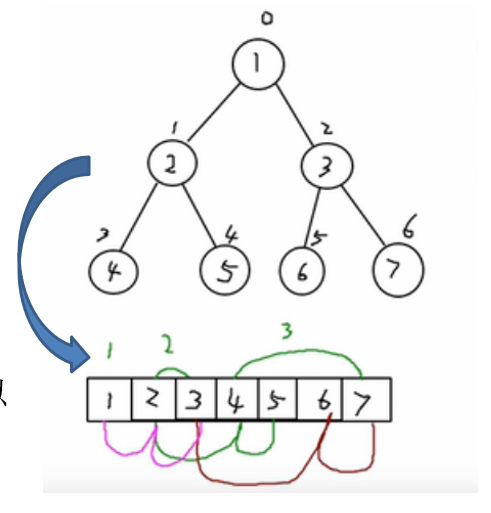
要求
上图的二叉树的结点,要求以数组的方式来存放 arr : [1, 2, 3, 4, 5, 6, 6]
要求在遍历数组 arr时,仍然可以以前序遍历,中序遍历和后序遍历的三种方式完成结点的遍历。
2.1 顺序存储二叉树的概念
顺序存储二叉树的特点:
- 顺序二叉树通常只考虑完全二叉树
- 第n个元素的左子节点为 2 * n + 1
- 第n个元素的右子节点为 2 * n + 2
- 第n个元素的父节点为 (n-1) / 2
n : 表示二叉树中的第几个元素(按0开始编号)
2.2 顺序存储二叉树的遍历方式
需求: 给你一个数组 {1,2,3,4,5,6,7},要求以二叉树前序遍历的方式进行遍历。 前序遍历的结果应当为 1,2,4,5,3,6,7
package itcast02;
// 顺序存储二叉树
// 操作:
// 1. 前序遍历
// 作业:
// 1. 中序和后序排序
public class ArrBinaryTreeDemo {
public static void main(String[] args) {
int[] arr = {
1, 2, 3, 4, 5, 6, 7};
ArrBinaryTree arrBinaryTree = new ArrBinaryTree(arr);
arrBinaryTree.preOrder();// 1, 2, 4, 5, 3, 6, 7
// 上面的重载函数, 使得我们不需要输入参数
}
}
// 编写一个ArrayBinaryTree类, 实现顺序存储二叉树
class ArrBinaryTree {
private int[] arr;// 存储数据的数组
public ArrBinaryTree(int[] arr) {
this.arr = arr;
}
// 重载preOrder
public void preOrder() {
this.preOrder(0);
}
// 编写一个方法, 完成顺序存储二叉树的前序遍历
/**
*
* @param index 这个表示数组下标, 相当于例子中的n
*/
public void preOrder(int index) {
// 如果数组为空, 或者 arr.length == 0
if(arr == null || arr.length == 0) {
System.out.println("数组为空, 不能按照二叉树的前序遍历。");
}
// 输出单前元素
System.out.println(arr[index]);
// 向左递归遍历
if ((index * 2 + 1) < arr.length) {
preOrder(index * 2 + 1);
}
// 向右递归遍历
if((index * 2 + 2) < arr.length) {
preOrder(2 * index + 2);
}
}
}
2.3 顺序存储二叉树应用实例
八大排序算法中的堆排序,就会使用到顺序存储二叉树, 关于堆排序,我们放在<<树结构实际应用>> 章节讲解。
3 线索化二叉树
先看一个问题
将数列 {1, 3, 6, 8, 10, 14 } 构建成一颗二叉树. n+1=7
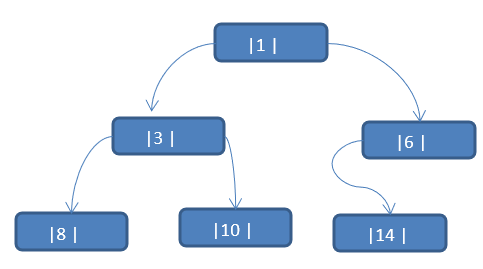
问题分析:
- 当我们对上面的二叉树进行中序遍历时,数列为
{8, 3, 10, 1, 6, 14 } - 但是
6, 8, 10, 14这几个节点的 左右指针,并没有完全的利用上. - 如果我们希望充分的利用 各个节点的左右指针, 让各个节点可以指向自己的前后节点,怎么办?
- 解决方案-线索二叉树
3.1 线索二叉树基本介绍
n个结点的二叉链表中含有n+1 【公式 2n-(n-1)=n+1】 个空指针域。
利用二叉链表中的空指针域,存放指向该结点在某种遍历次序下的前驱和后继结点的指针(这种附加的指针称为 线索)
这种加上了线索的二叉链表称为线索链表,相应的二叉树称为线索二叉树(Threaded BinaryTree)。
根据线索性质的不同,线索二叉树可分为前序线索二叉树、中序线索二叉树和后序线索二叉树三种。
一个结点的前一个结点,称为前驱结点。
一个结点的后一个结点,称为后继结点。
3.2 线索二叉树应用案例
应用案例说明:将下面的二叉树,进行中序线索二叉树。中序遍历的数列为 {8, 3, 10, 1, 14, 6}

线索二叉树应用案例
思路分析: 中序遍历的结果:{8, 3, 10, 1, 14, 6}

说明: 当线索化二叉树后,Node节点的 属性 left 和 right ,有如下情况:
- left 指向的是左子树,也可能是指向的前驱节点。比如 ① 节点 left 指向的左子树, 而 ⑩ 节点的 left 指向的就是前驱节点。
- right指向的是右子树,也可能是指向后继节点,比如 ① 节点right 指向的是右子树,而 ⑩ 节点的right 指向的是后继节点。
3.3 遍历线索化二叉树
说明:对前面的中序线索化的二叉树, 进行遍历
分析:因为线索化后,各个结点指向有变化,因此原来的遍历方式不能使用,这时需要使用新的方式遍历线索化二叉树,各个节点可以通过线型方式遍历,因此无需使用递归方式,这样也提高了遍历的效率。 遍历的次序应当和中序遍历保持一致。
代码:
package itcast03;
public class ThreadedBinaryTreeDemo {
public static void main(String[] args) {
// 测试一把中序线索二叉树的功能
HeroNode root = new HeroNode(1, "Tom");
HeroNode node2 = new HeroNode(3, "jack");
HeroNode node3 = new HeroNode(6, "smith");
HeroNode node4 = new HeroNode(8, "mary");
HeroNode node5 = new HeroNode(10, "king");
HeroNode node6 = new HeroNode(14, "dim");
// 二叉树,后面我们要递归创建。现在简单处理使用手动创建
root.setLeft(node2);
root.setRight(node3);
node2.setLeft(node4);
node2.setRight(node5);
node3.setLeft(node6);
// 测试中序线索化
ThreadBinaryTree threadBinaryTree = new ThreadBinaryTree();
threadBinaryTree.setRoot(root);
threadBinaryTree.threadedNodes();
// 测试(就是看某个节点的前驱和后驱是否是应该的那一个就行了):以10号结点测试
HeroNode leftNode = node5.getLeft();// 这地方应该是 5号
HeroNode rightNode = node5.getRight();// 这地方应该是 1号
System.out.println("10号结点的前驱结点是 = " + leftNode);
System.out.println("10号结点的后继结点是 + " + rightNode);
// 当线索化二叉树后, 能使用原来的遍历方法
System.out.println("使用线索化的方式遍历 线索化二叉树:");
threadBinaryTree.threadedList();// 8, 3, 1, 14,
}
}
// 创建ThreadedBinaryTree 实现了线索化功能的二叉树
class ThreadBinaryTree {
private HeroNode root;
// 为了实现线索化, 需要建立要给指向单前结点的前驱结点的指针
// 在递归进行线索化时, pre 总是保留前一个结点
private HeroNode pre = null;
public void setRoot(HeroNode root) {
this.root = root;
}
// 重载一把线索化的方法
public void threadedNodes() {
this.threadNodes(root);
}
//遍历线索化二叉树的方法
public void threadedList() {
// 定义一个变量, 存储当前遍历的结点
HeroNode node = root;
while(node != null) {
// 循环找到leftType == 1 的结点, 第一个就是 8结点
// 后面随着遍历而变化, 因为leftType == 1时, 说明该节点是按照线索化处理过的有效节点
while(node.getLeftType() == 0) {
node = node.getLeft();
}
// 打印单前的这个结点
System.out.println(node);
// 如果单前节点的右指针指向的是后继结点, 就一直输出
while( node.getRightType() == 1) {
// 获取到当前结点的后继结点
node = node.getRight();
System.out.println(node);
}
// 替换这个遍历的节点
node = node.getRight();
}
}
// 编写对二叉树进行中序线索化的方法
/**
* @param node 就是当前需要的线索化的结点
*/
public void threadNodes(HeroNode node) {
// 如果node == null, 不能线索化
if (node == null) {
return;
}
//(一) 线索化左子树
threadNodes(node.getLeft());
//(二) 线索化单前结点(有点难度)
// 1> 先处理单前结点的前驱结点
// 以8号结点来举例 .left = null, 8结点的 .leftType = 1
if (node.getLeft() == null) {
// 就让单前结点的左指针指向前驱结点
node.setLeft(pre);
// 修改单前结点的左指针类型,指向的是前驱结点
node.setLeftType(1);
}
// 处理后继结点
if (pre != null && pre.getRight() == null) {
// 让前驱结点的右指针指向当前结点
pre.setRight(node);
// 修改前前驱结点的右指针类型
pre.setRightType(1);
}
//!!! 每处理一个结点, 让当前结点是下一个节点的前驱结点
pre = node;
//(三) 线索化右子树
threadNodes(node.getRight());
}
// 删除结点
public void delNode(int no) {
if (root != null) {
// 如果这个地方只有一个root节点, 这里立即判断root是不是就是要删除的节点
if (root.getNo() == no) {
root = null;
} else {
// 递归删除即可
root.delNode(no);
}
} else {
System.out.println("空树, 不能删除~");
}
}
//前序遍历
public void preOrder() {
if (this.root != null) {
this.root.preOrder();
} else {
System.out.println("二叉树为空, 不可遍历。");
}
}
//中序遍历
public void infixOrder() {
if (this.root != null) {
this.root.infixOrder();
} else {
System.out.println("二叉树为空, 不可遍历。");
}
}
//后序遍历
public void postOrder() {
if (this.root != null) {
this.root.postOrder();
} else {
System.out.println("二叉树为空, 不可遍历。");
}
}
// 前序查找
public HeroNode preOrderSearch(int no) {
if (root != null) {
return root.preOrderSearch(no);
} else {
return null;
}
}
// 中序查找
public HeroNode infixOrderSearch(int no) {
if (root != null) {
return root.infixOrderSearch(no);
} else {
return null;
}
}
// 后序查找
public HeroNode postOrderSearch(int no) {
if (root != null) {
return root.postOrderSearch(no);
} else {
return null;
}
}
}
class HeroNode {
private int no;
private String name;
private HeroNode left;//默认null
private HeroNode right;//默认null
// 说明:
// 1. 如果leftType == 0 表示指向的是左子树, 如果 1 则表示前驱结点
// 2. 如果rightType == 0 表示指向右子树, 如果是 1 表示指向后继结点
private int leftType;
private int rightType;
public int getLeftType() {
return leftType;
}
public void setLeftType(int leftType) {
this.leftType = leftType;
}
public int getRightType() {
return rightType;
}
public void setRightType(int rightType) {
this.rightType = rightType;
}
public HeroNode(int no, String name) {
this.no = no;
this.name = name;
}
public int getNo() {
return no;
}
public void setNo(int no) {
this.no = no;
}
public String getName() {
return name;
}
public void setName(String name) {
this.name = name;
}
public HeroNode getLeft() {
return left;
}
public void setLeft(HeroNode left) {
this.left = left;
}
public HeroNode getRight() {
return right;
}
public void setRight(HeroNode right) {
this.right = right;
}
@Override
public String toString() {
return "HeroNode{" +
"no=" + no +
", name='" + name + '\'' +
'}';
}
// 递归删除节点
// 1. 如果删除的是叶子节点, 就删除该节点
// 2. 如果删除的是非叶子叶子节点, 则删除该子树
public void delNode(int no) {
// 思路:
/*
如果要删除的节点是非叶子节点,现在我们不希望将该非叶子节点为根节点的子树删除,需要指定规则, 假如规定如下:
如果该非叶子节点A只有一个子节点B,则子节点B替代节点A
如果该非叶子节点A有左子节点B和右子节点C,则让左子节点B替代节点A。
请大家思考,如何完成该删除功能, 老师给出提示.(课后练习)
后面在讲解 二叉排序树时,在给大家讲解具体的删除方法
*/
// 2. 如果单前节点的左子节点不为空, 并且左子节点就是要删除的节点, 就将this.left = null; 并且就返回(结束递归删除)
if (this.left != null && this.left.no == no) {
this.left = null;
return;
}
// 3. 如果单前节点的右子节点不为空, 并且右子节点 就是要删除结点, 就将this.right = null; 并且返回(结束递归删除)
if (this.right != null && this.right.no == no) {
this.right = null;
return;
}
// 4. 我们就需要向左子树进行递归删除
if (this.left != null) {
this.left.delNode(no);
}
// 5. 则就需要向右子树递归删除
if (this.right != null) {
this.right.delNode(no);
}
}
// 编写前序遍历的方法
public void preOrder() {
System.out.println(this);
//递归向左子树前序递归
if (this.left != null) {
this.left.preOrder();
}
//递归向右子树前序遍历
if (this.right != null) {
this.right.preOrder();
}
}
// 中序遍历
public void infixOrder() {
// 递归向左子树中序遍历
if (this.left != null) {
this.left.infixOrder();
}
//输出父节点
System.out.println(this);
//递归向左子树中序遍历
if (this.right != null) {
this.right.infixOrder();
}
}
//后序遍历
public void postOrder() {
if (this.left != null) {
this.left.postOrder();
}
if (this.right != null) {
this.right.postOrder();
}
System.out.println(this);
}
/**
* @param no 查找no
* @return 如果找到就返回该node, 如果没有找到就返回null
*/
public HeroNode preOrderSearch(int no) {
//比较当前节点是不是空,如果是空, 则递归前序查找
System.out.println("进入前序遍历:");
if (this.no == no) {
return this;
}
// 1. 如果不是,判断当前的左节点是不是为空, 则递归前序查找
// 2. 如果左递归前序递归, 找到节点, 则返回
HeroNode resNode = null;// 这个是为了做判断
if (this.left != null) {
resNode = this.left.preOrderSearch(no);
}
if (resNode != null) {
// 说明左子树已经找到了
return resNode;
}
// 1. 左递归前序查找, 找到节点, 则返回, 否继续判断
// 2. 单前的节点的右子节点为空, 如果不为空, 则继续右递归前序查找
if (this.right != null) {
resNode = this.right.preOrderSearch(no);
}
return resNode;
}
// 中序遍历查找
public HeroNode infixOrderSearch(int no) {
//比较当前节点是不是空,如果是空, 则递归中序查找
HeroNode resNode = null;
if (this.left != null) {
resNode = this.left.infixOrderSearch(no);
}
if (resNode != null) {
return resNode;
}
// 如果找到了,则返回。如果没有找到, 就和单前节点比较, 如果就是,则返回单前节点
System.out.println("进入中序查找:");
if (this.no == no) {
return this;
}
// 否则继续进行右递归的中序查找
if (this.right != null) {
resNode = this.right.infixOrderSearch(no);
}
return resNode;
}
// 后序遍历查找
public HeroNode postOrderSearch(int no) {
// 判断单前节点的左节点是不是为空, 如果不是, 则递归后序查找
HeroNode resNode = null;
if (this.left != null) {
resNode = this.left.postOrderSearch(no);
}
if (resNode != null) {
return resNode;
}
// 如果左子树没有找到, 则向右子树递归进行后序查找
if (this.right != null) {
resNode = this.right.postOrderSearch(no);
}
if (resNode != null) {
return resNode;
}
System.out.println("进入后序查找:");
if (this.no == no) {
return this;
}
// 如果左右子树都没有找到, 就比较单前节点是不是
return resNode;
}
}
3.4 线索二叉树应用案例
课后作业:
我这里讲解了中序线索化二叉树,前序线索化二叉树和后序线索化二叉树的分析思路类似,同学们作为课后作业完成.